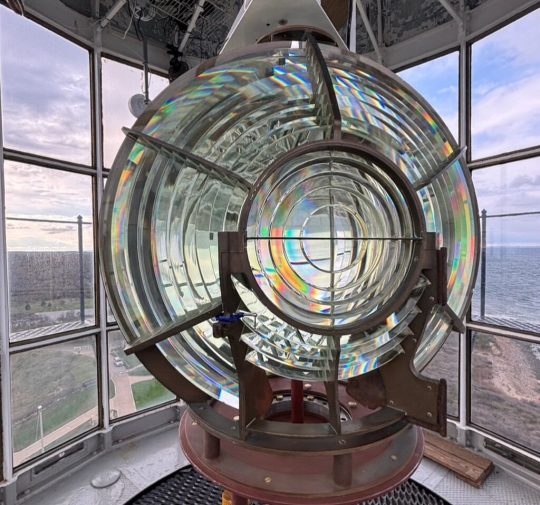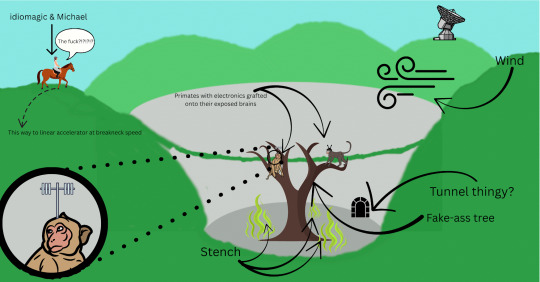#stanford linear accelerator
Explore tagged Tumblr posts
Text
And in the late 1960s, experiments at the Stanford Linear Accelerator revealed that even neutrons and protons themselves are made up of more fundamental constituents: each proton and each neutron consists of three particles known as quarks, as mentioned in Chapter 9 and illustrated in Figure 12.3a.

Instead, the conventional particle-as-dot model, according to string theory, is an approximation of a more refined portrayal in which each particle is actually a tiny, vibrating filament of energy, called a string, as you can see in Figure 12.3b.
"The Fabric of the Cosmos" - Brian Greene
#book quotes#the fabric of the cosmos#brian greene#nonfiction#60s#1960s#20th century#stanford linear accelerator#neutron#proton#quark#string theory#energy
0 notes
Photo

4:54 AM EDT May 27, 2024:
Man or Astro-Man? - "Song Of The Two-Mile Linear Particle Accelerator, Stanford University, Stanford, California" From the album A Spectrum of Infinite Scale (September 5, 2000)
Last song scrobbled from iTunes at Last.fm
File under: What was once surf-rock has become post-rock
#Man or Astro-Man?#A Spectrum of Infinite Scale#Song Of The Two-Mile Linear Particle Accelerator Stanford University Stanford California
0 notes
Text
Horse Story #8 for @elodieunderglass
Michael Vs. The Stanford Linear Accelerator, Part Two
(Part one is here: https://www.tumblr.com/idiomagic/785703810504015872/horse-story-7-for-elodieunderglass?source=share) When last seen, Our Heroes were confronted with the Unholy Sights, Sounds, and Stench of Monkey Hell. I had dropped my reins in shock, and Michael had decided that whatever the fuck was going on, it was Very Bad Juju and exited the vicinity posthaste. He got the bit in his teeth, and bugged out at full speed. Michael was not remarkably fast for a racehorse, but I had never before ridden at full racing speed. The fact that we were going cross country, on uneven ground, up and down hills, did not help matters. My reins were flapping everywhere, I immediately lost my stirrups, and my world narrowed down to an urgent imperative to Not Fall Off. I clung to the saddle, somehow, as we charged through tall grasses and prickly bushes. I managed to get my feet back in the stirrups, and got my brain working enough to assess the overall situation. It was Not Good. Michael was bolting at full speed, I had zero control, and we were aimed directly at the site of the linear accelerator. I had maybe half a mile or so to get Michael calmed down and regain my steering before we would plunge off the steep banks and plummet ten feet or so onto concrete at approximately terminal velocity. The Stanford Linear Accelerator extends for over a mile. It looks like this, though in places the banks are vertical, and in some places they are much closer to the building:

By the time I processed our Impending Doom, I knew we were fucked. I managed to get the reins into some semblance of order, but Michael was in no mood to respond to my suggestions that we slow the fuck down. He kept charging through the brush, we hit a downslope, then suddenly we were on the precipice of the bank, with a ten foot or more drop to the concrete, and the roof of the building about 15 feet away. So Michael did the only thing possible, and jumped. And landed on the metal roof. And, somehow, skittered to a stop instead of plunging off the other side. The roof was metal, and he slid a bit, all four legs splayed out, but we made it.

When we landed, the metal horse shoes hitting the roof at speed made the most colossally apocalyptic BOOM! CLANG CLANG CLANG! noise I've ever been unfortunate enough to hear. So, there we were...standing precariously on top of the most delicate, expensive, government run scientific installations in the world. With no obvious way down. I was aware that very soon, angry military types with guns would be heading our way, and that it was going to be very difficult to explain what the fuck we were doing there. The only plan I could think of was to sneak along the roof until we found a place where the banks were close enough to jump to. I wanted to attract as little attention as possible, in the hopes that maybe no one noticed the giant clanging noises that had heralded our arrival. I kept a very firm grip on the reins, but Michael had no intention to go his own way. He was baffled to be on top of a building, and eager to take any directions from me. He had confidence that I would have A Plan, which was heartwarming but sadly misplaced.
I picked the direction I hoped was away from the control building, and nudged Michael into a slow, sedate walk. A quiet walk. A sneaky walk. CLANG CLANG CLANG CLANG Oh shit. The noise was unreal. It was like being inside a steel drum during Carnival in the Caribbean. Only much less melodious and charming.

Well, I thought, no point in sneaking. And kicked Michael into a slow canter. Michael did not like the noise, at all, and when we came to a spot where the bank was more gentle and only about 8 or so feet away, he turned of his own volition and jumped. The quiet was such an intense relief. Michael was blowing hard, and covered with sweat, but I felt a strong need to make tracks and get away from the scene of our crime. We alternated between a jog and a slow canter, until we reached a clump of trees. We hid there for a couple of minutes while I took my bearings, then headed back towards the stable, walking and then jogging. We finally made it back, I gave Michael a bath, then wrapped his legs and got him back in his stall. Which is when the big black government sedan rolled up, with two Very Serious Dudes in full Men In Black suits and sunglasses. There were only a few people around at that time, and they were blissfully unaware of my crimes. I hid in the doorway of the stable, and listened. Very Serious Dude: "What do you people know about the incident at the linear accelerator? If you confess now, we will go easier on you." No one had any clue what he was talking about. Except me. Innocent Horse Person: "We have no idea what you're talking about. We've all been here all day. What's going on?" Very Serious Dude: "There was a horse on top of the accelerator. The noise and vibrations and dust from the ceiling disrupted an experiment that was three years in the making. We're going to all the stables to find the guilty party." Innocent Horse Person: "No one in their right mind would ride onto the accelerator. There's a lot of pasture up there...it must have been a loose horse. Or a deer. Or even a bull or something. It sure as hell wasn't any of us." The Very Serious Dudes left, unsatisfied. Later, one of the people from the barn came up to me. "What the hell were you up to? It had to be you and that Damned Horse. As soon as I realized that no one in their right mind would do it, I thought of you. It couldn't be anyone else. You're just fucking lucky to be alive." And I am.
------------------------------------------------------------------------------ If you like the Michael Stories, please reblog my pinned post and donate if you can. https://ko-fi.com/idiomagic
133 notes
·
View notes
Text
Settling a half century of debate, researchers have discovered that tiny linear defects can propagate through a material faster than sound waves do. These linear defects, or dislocations, are what give metals their strength and workability, but they can also make materials fail catastrophically—which is what happens every time you pop the pull tab on a can of soda. The fact that they can travel so fast gives scientists a new appreciation of the unusual types of damage they might do to a broad range of materials in extreme conditions—from rock ripped apart by an earthquake rupture to aircraft shielding materials deformed by extreme stress, said Leora Dresselhaus-Marais, a professor at the Department of Energy's SLAC National Accelerator Laboratory and Stanford University who co-led the study with Professor Norimasa Ozaki at Osaka University.
Continue Reading.
55 notes
·
View notes
Text

Innovative technique reveals that leaping atoms remember where they have been
University of Oxford researchers have used a new technique to measure the movement of charged particles (ions) on the fastest ever timescale, revealing new insights into fundamental transport processes. These include the first demonstration that the flow of atoms or ions possesses a "memory." The study, "The persistence of memory in ionic conduction probed by nonlinear optics," has been published in Nature. Whether charging a battery or pouring water, the flow of matter is one of the most fundamental processes in the universe. But a surprising amount remains unknown about how this occurs at the atomic scale. Understanding this better could help us solve a wide range of problems, including developing the materials needed for the technologies of tomorrow. In the new study, a team of researchers based at Oxford's Department of Materials and the Stanford Linear Accelerator (SLAC) National Laboratory in California made the surprising discovery that the movement of individual ions can be influenced by its recent past; in other words, there is "a memory effect." This means that, on the microscopic scale, history can matter: what a particle did a moment ago can affect what it does next.
Read more.
9 notes
·
View notes
Text
They also use these to align the Stanford Linear Accelerator!
If you're in the need for some kind of magical artifact of magic for your setting, consider Fresnel Lenses which are used in lighthouses:


These things are Alive.
28K notes
·
View notes
Text
Radiation Oncology The Basics Radiation oncology, also known as radiation treatment or radiotherapy, uses targeted doses of radiation to destroy cancer cells It is now the most common treatment for most types of cancer, but is not appropriate for all types and cases Though serious cost factors and side effects must be considered, radiation therapy is often the most effective, affordable, and least damaging treatment available Radiation therapy is also one of the oldest medically proven methods for combating cancer Origins & History of Radiation Therapy rays were discovered in Germany in 1895 by Wilhelm Conrad Rontgen, and in the same year Emil Grubbe made the first therapeutic use trying to treat a relapsed breast carcinoma in Chicago In 1896, X-rays were used to treat stomach cancer in France and a skin tumor on a four-year-old child in Austria, though the first real proof of a cure by this process did not appear until 1899 Radium was discovered by the Curies in 1898, and was used in a treatment known as "brachytherapy" for skin cancer in 1901 Ernest Rutherford's 1915 model of the atom explaining radioactive disintegration led to the development of radiation tubes III. Origin & History of Radiation Therapy: Part Two 1934 saw two major advancements in radiation therapy: the discovery of artificial radio-elements by Irene and Frederic Joliot-Curie (daughter and son-in-law of Mari and Pierre), and the publication of a 23% cure rate in head and neck cancers using X-rays by Dr. Henri Coutard In 1951, the first cobalt installation was made in Victoria Hospital in London, Ontario, and a year later the first linear accelerator was installed in Stanford In 1990, scanners and computers were utilized for Intensity-Modulated Radiation Therapy, which improved the efficacy and reduced the severity of side effects produced by the treatment by allowing for finer control of radiation levels and foci By the year 2000, half of all recovering cancer patients had been treated at least partially with radiation therapy, making it the most widely used and most effective cancer treatment External Radiotherapy: An Overview X-rays are taken to determine the precise location of tumors to be treated in radiotherapy Tattoos are often inked on the skin to mark the edge of the radiation filed, and blocks can be used to protect healthy tissue from the destruction of the radiation A radiation beam -- now aimed and controlled by computer -- is focused on the target area. This is usually repeated daily for several weeks. Internal Radiotherapy: An Overview Also known as brachytherapy, and generally more fraught with complications, internal radiotherapy can be recommended in some cases, especially when a surgery failed to completely remove the cancer and left still active remnants of a tumor A small source of radiation is placed inside a protective container and inserted as near as possible to the tumor, usually at the incision site when a surgery was performed Generally more destructive of surrounding healthy tissue, dosages of radiation are also lower. This technique is not as effective as a primary method of treating cancer Side Effects of Radiotherapy Fatigue, changes to the skin, and loss of appetite are all common side effects of radiation treatments. For treatments in the head and neck region, saliva production is also often inhibited, exacerbating appetite issues Loss of appetite also contributes to fatigue, and doctors recommend eating small meals more frequently as well as taking frequent short naps as a way of maintaining adequate energy and strength Skin problems often resemble deep tans or sunburns, and have similar root causes (i.e. radiation). Special lotions are available to soothe and protect the skin after radiation therapy The Cost of Radiotherapy The cost of radiation therapy can be quite high, depending on the number and frequency of treatment sessions needed as well as the duration of these treatments The equipment used in radiotherapy as well as the large amount of specialized training to practice radiation oncology are the major contributive factors to the cost of the treatment Most Medicaid plans and private insurers cover radiation therapies, as they are generally the least costly and most effective cancer treatments, even when compared to some pharmaceuticals Becoming a Radiation Oncologist Certification and licensing in radiation oncology requires two years of additional school and training after the completion of a medical degree and the standard two years of post-graduate clinical training, and competition for existing spots in training programs can be stiff Training in the use of the machinery, the medical effects of radiation, and the issues of direct patient care are all very extensive and highly complex areas of learning that must be mastered before certification and licensing as a radiation oncologist can be earned Many radiation oncologists specialize in specific types and areas of cancer to minimize costs to themselves and to patients References Abramson Cancer Center. (2006). "Radiation Oncology." University of Pennsylvania. Accessed 31 August 2009. http://www.oncolink.com/treatment/article.cfm?c=5&s=27&id=34&p=4 Fayed, L. (2009). "Radiation Therapy Overview." Accessed 31 August 2009. http://cancer.about.com/od/radiationtherapy/a/radiation.htm Heron, J. (2009). "Historical Data on Radiotherapy." Accessed 31 August 2009. http://www.oncoprof.net/Generale2000/g08_Radiotherapie/Index/g08-gb_idx02.html Read the full article
0 notes
Text
Suspect caught hiding in bushes after bolt cutting, attempted burglary: deputies
(KRON) — A man faces attempted burglary and vandalism charges after allegedly using bolt cutters on the property of the Stanford Linear Accelerator Center (SLAC) National Accelerator Library, according to the San Mateo County Sheriff’s Office (SMCSO). Tesla driver arrested for randomly threatening, pepper-spraying man in San Mateo Sheriff’s deputies were dispatched to the 2500 block of Sand…
0 notes
Text
Un día como hoy (1 de diciembre) en la computación

El 1 de diciembre de 1991, nace el primer servidor web, es el primero externo al CERN y fuera de Europa, con él nace el primer sitio web, este fue instalado en el SLAC (Stanford Linear Accelerator Center) y proveía acceso a SPIRES, una base de datos de información para científicos. Se puso en línea el 12 de diciembre #retrocomputingmx #webserver #1stwebpage
0 notes
Text
Reminds me that I drove over SLAC — the Stanford Linear Accelerator — last weekend. It’s a narrow but two-mile long building in the hills of Palo Alto, and highway 280 passes over & across it.
I’ve always thought it wonderful that something so exotic as a miles-long tube of vacuum ringed by magnets through which beams of subatomic particles fly at close to lightspeed rests in a bucolic setting near fields of cows. And that streams of cars traveling at only 70 miles per hour almost intersect those beams.


My latest cartoon for New Scientist
9K notes
·
View notes
Text
Scientists have found that human beings age at a molecular level in two accelerated bursts first at the age of 44, and then again at 60.

In a study published in the journal Nature Aging, scientists at Stanford University and Nanyang Technological University in Singapore followed 108 participants over several years to observe aging changes in their molecules - RNA, proteins and participants' microbiomes.
The scientists found that human aging does not happen in a gradual, linear way. Rather, the majority of the molecules they studied showed accelerated, non-linear changes at the ages of 44 and 60.
📸: skynesher/Getty Images
#allthenews
0 notes
Photo

4:38 AM EDT May 17, 2024:
Man or Astro-Man? - "Song Of The Two-Mile Linear Particle Accelerator, Stanford University, Stanford, California" From the album A Spectrum of Infinite Scale (September 5, 2000)
Last song scrobbled from iTunes at Last.fm
File under: What was once surf-rock has become post-rock
#Man or Astro-Man?#A Spectrum of Infinite Scale#Song Of The Two-Mile Linear Particle Accelerator Stanford University Stanford California
0 notes
Text
Horse Story #7 for @elodieunderglass
Michael Vs. the Stanford Linear Accelerator, Part One Content Warning: Animal abuse mention (not perpetrated on or by Michael) Stanford University owns over 8000 acres of land, much of it scrubby, rolling foothills. It leases parcels of land to government agencies, for science (like the particle accelerator) or other nefarious purposes. There are scattered missile silos up in those hills, delineated only by massive circular concrete pads. You can roam through those hills for days without seeing another person, or you can suddenly find yourself up against a 10 foot high fence plastered with cameras and warning signs and angry men with guns. It's a strange, vast area that looks like this:

When Michael and I were ordered to vacate our stable due to The Chicken Incident, I decided to move to a new stable that was partially on Stanford land. When you're riding on an international level, conditioning is key. I knew that Michael and I would be spending many days and many, many miles, working up and down hills. The stable was perfect, since we'd have access to the Stanford Hills. One day, we picked a direction and set out. And this happened:
We'd been out for an hour or so, trotting and cantering up and down gentle hills, in an area we hadn't explored before. We trotted up a larger than usual hill, and stopped short at the summit. Just below us, in a small valley/bowl surrounded by other hills, was...an installation? purposely hidden from sight. It was a round, concrete enclosure, like a small amphitheater with no seats, surrounded by a huge concrete wall. The whole thing was concrete...walls, floor, everything. In the middle was a huge fake tree that looked like it was also made of concrete, set in a pool of shallow water, maybe 2 or 3 inches deep. There was a dark opening, like a tunnel, in one of the walls, going into the hill. In the tree were monkeys. There were probably 4 or 5 monkeys, sitting listlessly on the branches of the fake tree, hooting mournfully. The tops of the monkeys heads were missing, replaced with metal plates with antennas emerging from them.

It looked like this:

(Many thanks to The Husband for the artistic rendering of Monkey Hell)
Michael and I stood at the top of the hill, mesmerized, horrified. I was in shock, I guess, which explains why I let the reins slide through my fingers. Which was the exact moment when the wind changed and blew straight towards us with an overwhelming and overpowering Stench of monkeys. And Michael realized that Antenna Monkeys Are Terrifying and Wrong, a viewpoint I wholeheartedly agreed with, grabbed the bit with his teeth, and bolted... ...at full speed, out of control, in the direction of the Stanford Linear Accelerator. To Be Continued When I Am No Longer In Stupid Amounts of Pain And/Or Projectile Vomiting at Surprising Intervals ------------------------------------------------------------------------------ If you like the Michael Stories, please reblog my pinned post and donate if you can. https://ko-fi.com/idiomagic
83 notes
·
View notes
Text

A foundation that fits just right gives superconducting nickelates a boost
Researchers at the Department of Energy's SLAC National Accelerator Laboratory and Stanford University say they've found a way to make thin films of an exciting new nickel oxide superconductor that are free of extended defects. Not only does this improve the material's ability to conduct electricity with no loss, they said, but it also allows them to discover its true nature and properties, both in and out of the superconducting state, for the first time. Their first look at a superconducting nickel oxide, or nickelate, that does not have defects revealed that it is more like the cuprates—which hold the world's high-temperature record for unconventional superconductivity at normal pressures—than previously thought. For instance, when the nickelate is tweaked to optimize its superconductivity and then heated above its superconducting temperature, its resistance to the flow of electric current increases in a linear fashion, just as in cuprates. Those striking similarities, they said, may mean these two very different materials achieve superconductivity in much the same way.
Read more.
4 notes
·
View notes
Text
Episode 038 -Vale Steve Albini Part 2
Continuing on from last week we played some of the vast catalogue that Steve Albini recorded.

Fun Things - Savage
Jesus Lizard - Nub Jesus Lizard - Chrome Jesus Lizard - Mistletoe
UrgeOverkilldozer - Evil Womyn (Black Sabbath) Urge Overkill - The Kids Are Insane Killdozer - Porky's Dad
Pixies - Bone Machine Pixies - Gigantic The Breeders - Cannonball
Pussy Galore - Understand Me Boss Hog - Gerard Jon Spencer Blues Explosion - Water Main Jon Spencer Blues Explosion - High Gear
Didjits - Top Fuel Didjits - Who's Ready To Get High Wrangler Brutes - Shit Search Wrangler Brutes - Unmentionables
The Mark Of Cain - UCD Lizard Train - Got The Fear Dirty Three - Sirena
Union Carbide Productions - High Speed Energy Tad - Woodgoblins Mclusky - Undress For Success Mclusky - Beacon For Pissed Ships
Nirvana - I Hate Myself And Want To Die Nirvana - Frances Farmer Will Have Her Revenge On Seattle Cheap Trick - Clock Strikes Ten The Stooges - Trollin'
Man Or Astroman? - Sferic Waves Man Or Astroman? - Song Of The Mile Linear Particle Accelerator, Stanford University, Stanford California Weedeater - Wizard Fight Big Black - Crack Up
Shellac - Il Porno Star
1 note
·
View note
Text
In Turkey
I'm now travelling through Turkey, with almost no money, wondering what will happen to me.
Every day in this experience of poverty it seems like I remember John Hagelin with his giant head and hand, handing me my physics degree. He had a PhD from Harvard and a postdoctoral degree at the Stanford Linear Accelerator, which are more prestigious than anything available in France or Quebec. I was born in Quebec. I was imagining myself as a higher metabolism animal that scurried away and keep mixing him in my mind with Dean Moriarity in On The Road and his "massive dongle", and then I mix that in my mind with the scene in The Kite Runner where one American laughs and slaps the other on the back.
As for being Alexander reincarnated, if I am the Heartbreak Prince, all my musical support has a strong Babylon theme, which would match Kalonos's last words before he stepped in the fire. So I was thinking one side has music no one wants, and the other has popular music but with a strong Babylon theme. That struck me as funny. I was sensing I'm in the middle of an Asian-style purge, and my feeling of expansiveness is really strong along with the obvious non-expansiveness of poverty and being severed from family including my parents. We'll see how this all plays out.
0 notes